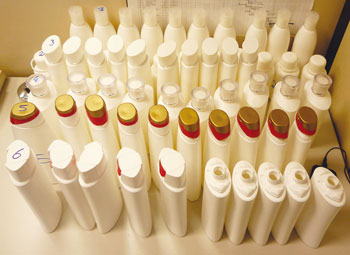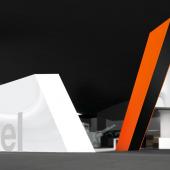Value at end of line
ROBOTIZED ISLANDS Tiesse Robot has developed an innovative solution for automatic bottle capping for cosmetic products. With a vision system that totally guarantees quality.
By request of an important customer, Tiesse Robot of Visano (BS) has recently created an automatic installation for manipulating caps for flacons that integrates a filling line for liquid soaps, detergents, shampoos and similar products.
The system consists in a robotized island characterized by an original design and high technological knowhow, meeting numerous user requirements, starting with compatibility with the pre-existing filling line and a capacity for manipulating 9 different closure types with the help of a feed system that has been re-equipped ad hoc for the purpose. The closures in question are divided between screw-on and press-on caps; in the case of the latter, the installation must also perform preliminary phasing during the placing phase.

Optimized logistics The cap manipulation device chosen is a TH450A model Scara Toshiba, identified as particularly suitable for the available space and work cycle time required, which can vary, according to the cap type, between 1 and 2.3 seconds. Manipulation is performend with the help of a sucker mounted to a 100 liter motorized hopper that functions as a loading phaser. The vibrating cup is  connected to a linear vibration device, which is equipped with special alignment and cap spacing systems and operates in the picking area serviced by the robot. A motorized belt enables recycling caps facing the wrong way. Caps are screwd on by the Scara robot, which rotates its flange by 90-180 degrees, while press-on assembly is performed with the help of the compensated slide on which the sucker is mounted.
connected to a linear vibration device, which is equipped with special alignment and cap spacing systems and operates in the picking area serviced by the robot. A motorized belt enables recycling caps facing the wrong way. Caps are screwd on by the Scara robot, which rotates its flange by 90-180 degrees, while press-on assembly is performed with the help of the compensated slide on which the sucker is mounted.
Vision: an added value. The special characteristic of this installation is the integration of a TS Vision system connected to three videocameras with lights, mounted onto a single support base. Camera 1, installed on the vertical axis, captures the caps coming in from the feed system and transmits their positioning to the robot. Number 2, with horizontal axis, sees which way the cap that needs to be phased onto the container is facing.
The third camera, with vertical axis, is located above the area in which the cap is placed on the flacon, and verifies its correct positioning, first of all in relation to the kneck of the container. The system monitors the various alarms to call attention to the operator in case of malfunctions; furthermore, it enables verifying that each cap corresponds to the model being produced.


















